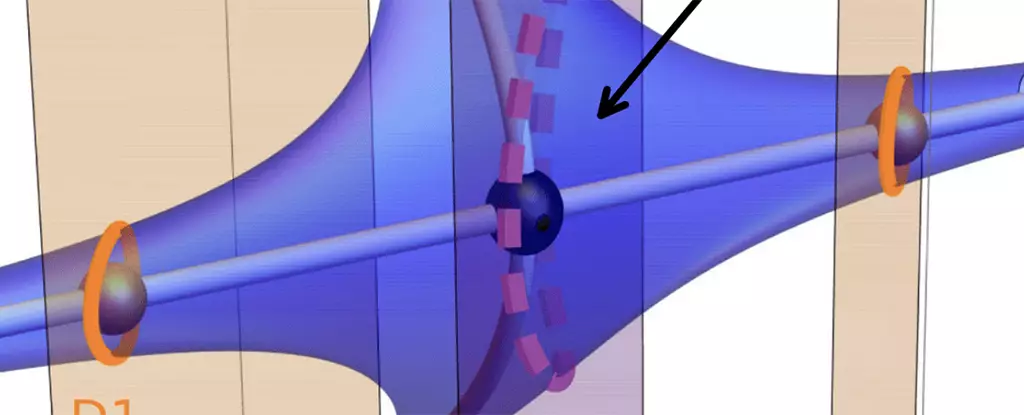In an extraordinary development for the fields of physics and materials science, researchers have unearthed a novel quasiparticle known as the semi-Dirac fermion, which defies conventional understandings of mass. Sixteen years after its theoretical existence was first proposed, this discovery opens new avenues in quantum physics and may have profound implications for technology, notably within electronic sensors.
Quasiparticles are essentially collective excitations that exhibit particle-like behavior, allowing physicists to understand complex interactions in condensed matter systems. Typically, one would expect a particle’s mass to remain invariant irrespective of its directional movement. However, the newly discovered semi-Dirac fermion operates under an entirely different paradigm that could challenge long-standing principles in the field.
In physics, mass often intertwines with notions of energy, inertia, and motion. The usual understanding sees mass as a constant that influences how a particle interacts with forces—an established parameter that holds true for many. However, the semi-Dirac fermion deviates from this universal rule by having an “effective mass” that varies with direction. Specifically, it exposes a condition where the particle operates without mass in one axis, yet possesses mass in another. This duality presents an unprecedented perspective on how particles behave within various contexts, hinting at the intricate tapestry of particle physics.
Research indicates that this phenomenon may reflect the material’s inherent electronic structure, a complex scaffold that influences how particles travel through it. This revelation could potentially illuminate the pathways towards enhanced electronic devices and quantum computing systems.
The groundbreaking observation was made within the crystalline structure of ZrSiS, a semi-metal that demonstrates peculiar electrical properties at extremely low temperatures—just a fraction above absolute zero (-269 degrees Celsius or -452 degrees Fahrenheit). Under these conditions, the semi-Dirac fermions displayed their unique capabilities. The researchers utilized magneto-optical spectroscopy, an advanced technique involving the analysis of infrared light emissions under a powerful magnetic field approximately 900,000 times stronger than that of Earth. This methodological approach allows for the exploration of materials at micro and nanoscopic levels, revealing phenomena that are otherwise concealed.
Initial explorations did not seek specifically for semi-Dirac fermions; the research team had stumbled onto their signatures unexpectedly. It is a testament to serendipity in scientific discovery, where sometimes the most transformative insights arise from unanticipated observations. Condensed matter physicist Yinming Shao from Pennsylvania State University highlighted the surprises encountered during this investigation, reinforcing how unpredictability often drives scientific advancement.
To elucidate this complex behavior, the researchers provided an engaging analogy comparing the semi-Dirac fermion to a miniature train navigating a network of tracks. When the train travels on a straight route, it represents massless motion, akin to light speed. However, upon hitting an intersection that forces the train to switch tracks—akin to a change in direction—resistance is met, akin to the presence of mass in this scenario. This analogy is a valuable tool for understanding these intricate physical phenomena, making them accessible even to those without advanced physics backgrounds.
While this discovery marks a pivotal moment in the understanding of quasiparticles, it is essential to recognize that there is a vast unchartered territory ahead. Much remains to be explored regarding the properties and potential applications of semi-Dirac fermions. For instance, one of the next challenges for research teams involves determining methods to isolate single layers from the multi-layered ZrSiS crystal. Mastering this technique is crucial for truly harnessing the semi-Dirac fermion’s transformative properties in practical applications.
As researchers delve deeper into these enigmatic quasiparticles, the excitement lies not just in the discovery itself but in the possibilities it presents for future technological innovations. The fields of quantum mechanics and materials science may be on the brink of a new era, one where previously unimaginable applications come to fruition. Shao optimistically noted that the current data is not yet fully interpreted, suggesting that further revelations are likely to emerge, potentially rewriting elements of our understanding of particle physics.
The discovery of the semi-Dirac fermion is a clear reminder of the dynamic and unfolding nature of scientific inquiry. It emphasizes that even established theories may need reevaluation in light of new evidence, pushing the boundaries of our understanding about the building blocks of matter. As the scientific community turns its gaze toward the challenges and opportunities that lie ahead, one can only speculate how the semi-Dirac fermion’s properties will be integrated into future technological innovations, thereby exemplifying the symbiotic relationship between pure science and practical utility.

